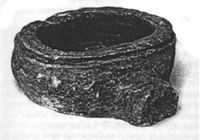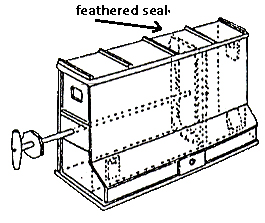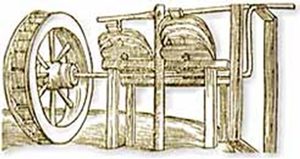
(Tomb of Rekhmire, Egypt, ca. 1450 BC)
Who invented the first bellows?
About 14,000 BC, potters in China started to use kilns to fire clay pots. By about 3500 BC, people in West Asia were beginning to use furnaces to smelt metal – to burn copper and tin ore and melt it to get the copper and tin out, and mix them to make bronze. To melt bronze, you needed a hotter fire than for pottery, so metalworkers used charcoal to make the fire hotter. They designed the furnaces so that rising hot air would draw more air into the furnace. They built clay tubes going down into the furnace and had enslaved men stand at the other end of the tubes and blow into them to get more oxygen into the fire so it would burn hotter.
More about bronze
Oxygen and fires
History of slavery

Pot bellows from Tell edh-Dhiba’i (modern Baghdad), ca. 1800 BC
The invention of the pot bellows
By around 1800 BC, Babylonian and Hittite metalworkers were using a pot bellows to smelt copper. You stretched leather over the top of a clay or limestone pot and pulled the leather top up with a string or a stick to fill the pot with air, then stomped on the pot to push the air out into the fire, over and over.
A pot bellows turned out to create enough heat so you could smelt iron ore and get usable iron out of it. This same bellows could also be used to melt glass, and almost immediately people in Syria and Lebanon started to use pot bellows to make the first core-formed glass bottles and glass beads. Soon New Kingdom Egyptians were also using pot bellows to smelt metal.
History of glass
History of iron and steel
Who were the Hittites?

Double-action piston box bellows (China)
Who invented the box bellows?
By 400 BC, people in China used ox-hide bellows. They were using more efficient double-action piston box bellows by the early Han Dynasty, about 200 BC. These bellows blow air both when they’re opened and when they’re closed, so they’re more efficient than the pot bellows.
Han Dynasty China
You pull the piston towards you, and it pulls a sealed wall towards you. The far half of the box gets bigger, and sucks in air, while the near half gets smaller and pushes out air. Then you push the piston in again, and the near half of the box gets bigger, and sucks in air, while the far half gets smaller and pushes out air.
Using waterwheels to power the bellows

A watermill-powered box bellows
About 50 BC, the Han Dynasty engineer Hu Shi invented a way to use a horizontal waterwheel to push the piston on the box bellows in and out. Using water power, the box bellows could be made much bigger and stronger, so furnaces could be hotter.
Pot bellows south of the Sahara
By about 100 AD, blacksmiths in Sudan were using a pot bellows to smelt iron. In some parts of Africa, people made pot bellows with wooden bowls. People began to use bellows in pairs so one could be sucking in air while the other was blowing out,to keep the fire steady. In Uganda, blacksmiths thought of bellows as coming in pairs, as parents, to make the metal babies.
East African history
After about 1000 AD, probably learning from India, some African iron furnaces relied on natural draft, drawing in air from the bottom as hot air rose out of the top.

Vanocchio Biringuccio, Water-wheel bellows (Venice, 1540)
Who invented the bag bellows?
By 1100 AD (and maybe earlier?) blacksmiths in medieval Europe were using bag bellows, made out of the whole skin of a sheep, carefully removed in one piece without tearing it so it would hold air like a balloon. Not long after 1500, people in southern Africa were also using bag bellows, usually also made from goat or sheep.
Thanks! thats interesting
You’re welcome. Glad we could help.
I need more photos
Hi Emma! Photos of what exactly?